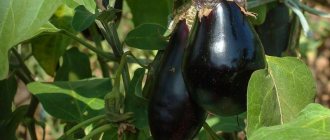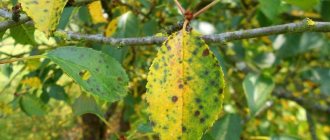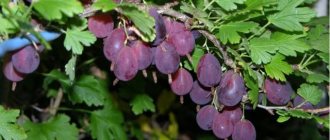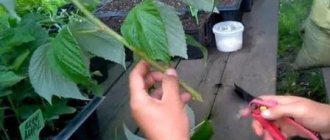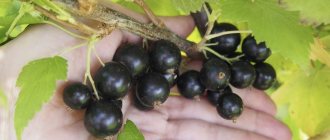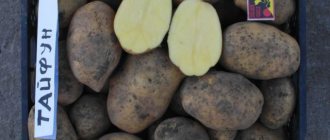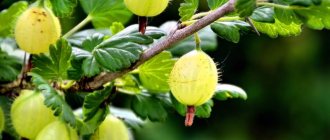Vegetable growing » Eggplant
0
1003
Article rating
Kira Stoletova
People call eggplants “little blue”. Eggplant The samurai sword was named for its resemblance to the blade of Japanese warriors. The variety is young and has only recently appeared on the seed market, so it is especially interesting for all gardeners.
Characteristics of eggplant variety Samurai Sword
Description and characteristics of the variety
Despite the fact that eggplant is a heat-loving crop, it is very popular among gardeners in our country. As a rule, several specific varieties are grown every year, which guarantees good results and taste. They also try to grow a new variety every year as an experiment. Perhaps the harvest will be so high that it will take its rightful place in the permanent collection.
Let's talk about the Samurai variety. Its main characteristics:
- growing conditions: open ground and greenhouses;
- description of the fruit: elongated shape with dark purple glossy skin, weighing up to 200 grams;
- taste: excellent, without bitterness;
- planting pattern: 70×40;
- resistance to drought, heat, Colorado potato beetle, verticillium wilt, and spider mites;
- ripening: mid-early variety, up to 120 days.
White eggplants
You can’t even imagine how beautiful the white eggplant fruits are.
White Lily
The fruits of this variety are white, delicate in taste, reminiscent of champignons and tender chicken meat. Harvest can be done on the 100th day. The bush is tall and strong, branched, it bears fruits with an average weight of 280 g. The variety is not demanding in care and cultivation, suitable for cultivation in open and closed ground.
White Night
This variety allows you to grow teardrop-shaped eggplants. One vegetable weighs 500-600 g. The height of the bush is 80 cm, it can ripen up to 6-9 fruits, the average weight of which is 200-270 g. Ripe vegetables can be harvested on the 105th day. The pulp is tender and does not taste bitter, and the harvested crop is suitable for long-term storage and transportation.
White Swan
This variety has dense pulp, so vegetables can be stored for a long time. White Swan is a mid-season type of eggplant, since harvesting occurs on the 110th day after entry. The height of the bush is 60-80 cm. When ripe, vegetables weigh 100 g, only they have thin skin.
It is better to grow this type of eggplant in closed ground with a constant temperature regime. Up to 12 fruits can be picked on one bush. Vegetable crops can be cultivated in open ground only if reliable protection from frost is created.
Swan
This is an early variety that is suitable for growing in open ground. If you regularly water the plants and maintain the temperature at least 20 degrees, then you can harvest the crop 85-100 days after germination. An adult vegetable weighs up to 300 g, and one bush contains up to 5 fruits.
Features of cultivation
When you come to the store to buy eggplant seeds in winter, you need to understand that all varieties will require certain conditions:
- warm conditions;
- timely watering;
- good lighting;
- looseness of the soil.
"Samurai" f1 eggplant is one that suffers from short-term drought and temperatures above + 28-30 degrees Celsius.
Eggplant "Samurai" f1 has passed ground control, which means that all the seeds were previously planted in the ground by specialists, and a harvest was obtained from them. This allows:
- determine germination;
- establish germination energy and, in fact, growth;
- confirm the quality and productivity of the variety.
Eggplant is a non-native crop for Russia, so anyone who has encountered growth finds it difficult, since it is problematic to maintain the optimal temperature for a long period of growth. Please note that even such an early variety of eggplant as “Samurai” ripens within 110-120 days from the moment the first shoots appear. That is why the entire growing process is divided into two stages:
- growing seedlings;
- planting and growing seedlings in the ground.
Where is the best place to grow eggplants?
In open groundIn greenhouse
“Samurai” seeds are planted in separate cups, so that the plant does not suffer during transplantation. As a rule, in the central zone of Russia, sowing begins on March 10 and ends on March 20.
With the onset of spring, the gardener needs to decide which days are best to start growing vegetables and flowers. In this article, you will learn when to sow vegetable seeds, taking into account the recommendations of the lunar calendar for March 2021.
Deepen the seeds by 1 centimeter, no more. In this case, the soil should be moistened, then you need to do the following:
- If there is not enough sunlight, the seedlings should be illuminated. This is very important, as eggplants love light and warmth. Additionally, you will need to move the seedlings to a cooler location overnight. This will create conditions close to real ones.
- When transplanting seedlings of the Samurai variety, you will need to do this according to the 70x40 pattern.
- If you watch the sowing time, the eggplants can be transplanted into open or closed ground between May 20 and May 30.
- Before planting, organic fertilizers are introduced, which eggplants love.
Eggplants produce a rich harvest. It is noted that from one square meter will be collected from 4 to 5 kilograms of long fruits with excellent taste. The Samurai eggplants themselves will have an elongated, long shape. The plant is semi-spreading, its height is 60 centimeters and below with a large number of leaves. Partial shade is not necessary for a plant of this variety, because it provides the necessary protection for the fruit from bright sunlight.
Description of the variety
Samurai Sword eggplants are a mid-season variety. From the beginning of planting to fruiting, 110-120 days pass. The plant bears fruit for a long time, bringing a large harvest. The variety was bred specifically for the temperate latitudes of the Central regions.
The bush grows up to 50-60 cm in height. The stems are green. The leaves are large, dark green, with a wavy edge.
The fruits reach a length of 20 cm and a diameter of 6-7 cm. The weight of a ripe eggplant is 160-200 g. The fruits are covered with a thin, glossy skin of a deep purple color. The pulp is whitish, without bitterness, contains a minimal amount of seeds. The shape is more elongated and curved compared to classic eggplant varieties. There are no sharp thorns on the cup.
With proper care, the fruits ripen several times on one cluster. From one square meter, 4-5 kg of vegetables are harvested.
Care
Every 2-3 days after planting, it is necessary to water the planted seedlings.
The main concern is weeding, loosening the soil, applying fertilizers (phosphorus and nitrogen), regular watering, pest control (aphids, Colorado potato beetles, spider mites, thrips):
- Against viral diseases, it makes sense to keep the seeds in a 1% solution of potassium permanganate, and for diseases during the growing season, it makes sense to use a solution of soda and copper sulfate.
- Many people mechanically collect the Colorado potato beetle in their areas or usually use bitoxybacillin.
Expert opinion
Filatov Ivan Yurievich, private farmer for more than 30 years
In greenhouses, newly planted seedlings can be fed with a solution of chicken (bird droppings 1:15) or mullein (1:10) per 1 m2, use a bucket, after fertilizing, repeat after 1 week. If the seedlings grow very poorly, a third feeding is necessary.
Due to lack of watering, heat, increased temperatures in summer, and lack of vitamins in the soil, eggplants can lose buds, flowers and ovaries, which threatens yield loss.
Landing
Seeds are sown 70 days before the planned transplant to a permanent location. The soil is made up of the following components: turf, compost, peat, rotted humus.
The nutrient compost composition should be 2 times more turf. For 10 kg of substrate add 35-40 g of phosphorus-potassium additive.
For containers for seedlings, peat cups with a volume of 300 ml and boxes with a side of 11-12 cm are suitable. Do not add 1 cm of soil. Form grooves in the moistened substrate in increments of 5 cm.
In the temperate zone, planting time is February and March.
What are the points of caring for seedlings:
- watering with a spray bottle;
- maintaining the temperature at 24-27 degrees;
- feeding before and after diving (2 times only);
- hardening 11-14 days before transplantation.
To fertilize seedlings, nitrogen fertilizers are needed, such as urea, manure solution, and nitroammophoska.
Diseases and pests
Some diseases and pests of eggplant can not only significantly reduce the yield of this crop, but also completely destroy young plants. Vegetable pests such as the Colorado potato beetle or mole cricket often cause the death of eggplant seedlings, which leads to the need for replanting.
Medvedka
Various etiologies of the disease are also very dangerous for this crop. Some of the most dangerous are various types of rot, blackleg and mosaic. To prevent diseases of vegetables and harm from pests to plants, it is necessary to follow eggplant agricultural practices and use various preventive measures.
If vegetable diseases and pests still affect eggplants, it is necessary to take measures to combat them:
- For this purpose, a whole arsenal of modern chemicals is used, among which there are also safe drugs.
- In addition, diseases and pests of eggplants are well destroyed by years of proven folk remedies, the preparation of which uses ingredients that are safe for human health.
Growing and care
The Samurai Sword eggplant does not require much effort to cultivate. Watering begins a week after transplantation. Fertilizing is applied 2 weeks after planting the bushes.
When the leaves turn pale, use nitrogen compounds (nitrophoska, ammonium nitrate). If fruit set begins, irrigation is carried out with a solution of boric acid. For feeding during flowering and fruiting, a product is made from droppings, bio-infusion, and phosphorus-potassium additives. After dilution, 500 ml is poured under 1 bush.
Photo
The photo shows the Samurai eggplant.
The most productive varieties of eggplant
If you are interested in both the quality of the fruits and their quantity, then the following varieties are suitable for you.
Striped flight
This is a mid-season type of eggplant, which is also high-yielding. It can be used for growing in open and closed ground. The variety is resistant to weather changes, and gardeners love it for its high fruit set in any conditions.
The pulp is tender, there is no bitterness or voids. The harvested crop tolerates transportation well and can be stored for a long time.
Black handsome late
When growing this type of eggplant, you can get the first harvest 130 days after germination. The bush is low, the branches are spreading. Vegetables are pear-shaped, their color is black and purple. One eggplant weighs up to 900 g.
Sophia
This is a late-ripening plant that produces a high yield 130-145 days after germination. The fruit is large, pear-shaped, and dark purple in color. One eggplant weighs 700-800 g. The pulp is light and has excellent taste.
The variety resists negative weather conditions and common eggplant diseases. Sophia is suitable for cultivation in open and closed ground.
